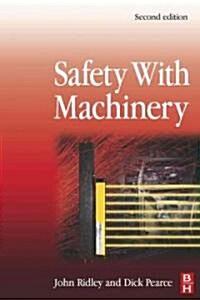책 이미지

책 정보
· 분류 : 외국도서 > 과학/수학/생태 > 과학 > 환경과학
· ISBN : 9780750667807
· 쪽수 : 294쪽
· 출판일 : 2005-12-12
목차
Preface to the second editionPreface to the first editionPART I ? SAFEGUARDING PHILOSOPHY AND STRATEGY1 Safeguarding of work equipment1.1 Introduction1.2 Design considerations1.3 Life cycle1.4 Designer’s responsibility1.5 Safeguarding principles1.6 Guarding strategy1.7 Unit vs holistic approach to safeguarding1.8 EU Directives in machinery safety1.9 Standard-making bodies1.10 European approach to machine guarding1.11 Interpretation of standards1.12 Arrangements in the USA2 Factors affecting the selection and effectiveness of machine safeguards2.1 Introduction2.2 Basic factors2.3 Quality assurance2.4 Reliability2.5 Integrity2.6 Validation2.7 Difficulties in applying some safety standards2.8 Summary3 Typical hazards of machinery3.1 Identification3.2 Agents of hazards3.3 Hazards from parts of machinery and work equipment4 Risk assessment, risk reduction and selection of safeguards4.1 Introduction4.2 What is a risk assessment?4.3 Risk reduction strategy4.4 Relevant standards4.5 Determining a safety integrity level for machinery hazards4.6 Selecting a safeguarding system4.7 SummaryPart II ? GUARDING TECHNIQUES5 Mechanical guarding5.1 Introduction5.2 Guard selection5.3 Guard types5.4 Other factors to consider5.5 Other techniques6 Interlocking safeguards6.1 Introduction6.2 Interlocking devices6.3 Guard locking6.4 Interlocking systems6.5 Levels of risk6.6 Interlocking media6.7 Two hand controls6.8 Hold-to-run controls6.9 Limited movement control6.10 Person sensing devices6.11 Lasers6.12 Pressure sensitive mats6.13 Pressure sensitive edges and wires6.14 Grab wires6.15 Emergency stop switches6.16 Telescopic trip switches6.17 Proximity switches6.18 Key exchange systems6.19 Key interlock switches6.20 Delayed start6.21 Other interlocking devices7 Ergonomic aspects of machinery safeguarding7.1 Introduction7.2 Physiology7.3 Controls7.4 Machine layout7.5 Colours7.6 Lighting7.7 Noise7.8 Vibrations7.9 Rate of working7.10 Temperature and humidity7.11 Ventilation7.12 Repetitive actions7.13 Warnings7.14 Vision7.15 Radiations7.16 Indicators and instruments7.17 CodaPart III - SAFEGUARDING SYSTEMS8 Mechanical safety arrangements8.1 Introduction8.2 Guards8.3 Distance fencing8.4 Safety gaps8.5 Feed and take-off stations8.6 Work-holding devices8.7 Counter-weights8.8 Safety catches8.9 Braking systems8.10 Clutches8.11 Summary9 Electrical safety circuits9.1 Introduction9.2 Effect on safety9.3 Basic safety requirements9.4 Selection of interlocking switches9.5 Switching contact requirements9.6 Factors influencing the selection of interlocks9.7 Circuit fault protection9.8 Safety control circuits9.9 Quantitative analysis10 Hydraulic safety circuits10.1 Introduction10.2 Hydraulic systems for safety circuits10.3 Hydraulic safety circuits11 Pneumatic safety circuits11.1 Introduction11.2 Pneumatic installations11.3 Pneumatic safety circuits11.4 SummaryPart IV - OTHER SAFETY RELATED ARRANGEMENTS12 Safety in the use of lifting equipment12.1 Introduction12.2 Common safety features of lifting equipment12.3 Additional features for particular lifting equipment12.4 Lifting accessories12.5 Circumstances requiring special precautions12.6 Precautions when handling lifting equipment13 Safety with pressure systems13.1 Introduction13.2 Compressed air13.3 Hydraulic installations13.4 Steam13.5 Process plant14 Safe working with equipment14.1 Introduction14.2 Systems of work14.3 Protection from electric shock14.4 Locking off14.5 Ergonomics14.6 Anthropometrics14.7 Openings in guards14.8 Operating instructions and manuals14.9 Labels on equipment14.10 Supervision14.11 Use of jigs and fixtures14.12 Safety clothing14.13 Stored energy14.14 Signs and signals15 Plant layout and the working environment15.1 Introduction15.2 Space15.3 Buildings15.4 Services15.5 Ventilation15.6 Lighting15.7 Temperature15.8 Machine layout15.9 Noise15.10 Vibrations15.11 Materials handling15.12 Maintenance15.13 Waste15.14 Access15.15 Lubrication15.16 Dust and fumes15.17 Floors and foundations15.18 Hygiene15.19 Notices and signs15.20 Explosive atmospheresPart V - APPENDICES1. Published standards2. Glossary of terms3. Abbreviations4. Smooth shaft pick-up5. Pipeline colour codes6. Permit-to-work7. Protection of enclosuresIndex


























